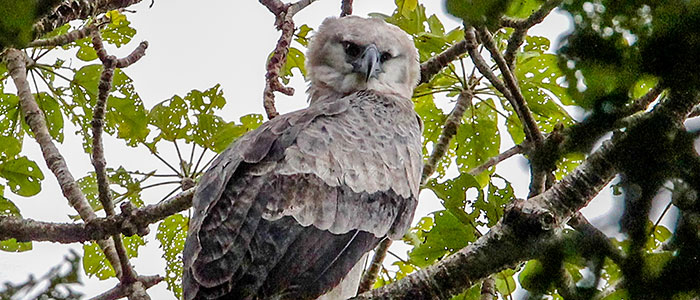Biodiversity 101: Professors Bring Back Lessons from a Pristine Rainforest

Posted by: Elizabeth Richardson on November 12, 2018, No Comments
Three East Stroudsburg University professors traveled deep into the largest pristine rainforest in Central America in part to see the elusive Harpy Eagle, the world’s most powerful raptor that is so distinctive it was the inspiration for the phoenix in the Harry Potter movies.
It was on the fourth day of their nine-day summer sojourn into the 1.4 million-acre Darien National Park in Panama, that Biology professors Terry Master, Tom LaDuke and Howard (Sandy) Whidden saw the Harpy Eagle 100 feet up in a tree. The professors were traveling with a small group that included faculty from Moravian College, Delaware Valley College and Lafayette College, along with their spouses.
Seeing the Harpy was a highlight of a journey chock full of memorable moments in that biologist’s paradise. Master, LaDuke and Whidden returned with a wealth of information to share with ESU students, including those in the Biology of Tropical Ecosystems course they teach in the spring.
“We have personal experiences and stories we can incorporate into our lectures and photographs we can use in our classes,” Whidden said.
Each spring break, they take students from the class on a nine-day trip to a Costa Rican rainforest. The students get to study numerous species and their habitats around the El Zota biological field station, which LaDuke helped establish.
“With all the talk about the loss of the rainforest, a lot of people never see it,” LaDuke said. “So we think it’s important for students to be able to visit and experience the biodiversity that occurs there. For a lot of students, it’s the peak of their college careers to go on this trip to Costa Rica.”
LaDuke, who specializes in the study of reptiles and amphibians, said the trip to Panama gave them a new perspective on Central American biodiversity.
“I think I can speak for all of us in saying we’re all biodiversity junkies, so seeing species that we’ve never seen before is always thrilling for the three of us,” LaDuke said. “I saw quite a few species of amphibians and reptiles, frogs and little lizards that I’ve never seen before and for me that was quite a treat.”
For Master, who specializes in the study of birds, the biggest thrill was seeing the Harpy. With legs the thickness of a man’s wrist and a wing span that can reach 6 ½ feet, Harpys prey on sloths and monkeys, grabbing them with talons as long as those of a grizzly bear.
The Harpy requires a huge territory for hunting, which is why its numbers would diminish rapidly without rainforests such as the expansive Darien preserve. The rarest bird the group saw was the Solitary Eagle, which had only been seen five times in Panama prior to their visit, according to the latest Panamanian field guide.
To get to the Darien rainforest preserve, the travelers flew to Panama City, took a 6 ½ hour van ride to the eastern end of Panama, followed by an hour in a motorized canoe, then an hour in a pickup truck and finally a 2 ½ mile walk to a ranger station and bunkhouse where they stayed.
They saw a few rangers and met indigenous people from the Embera tribe, but saw no other visitors in the remote park.
The professors were in awe of their guides, Isaac Pizzaro and Israel Mesen, who were adept at doing hikes over treacherous terrain that taxed the Americans. On a day hike up the El Estrangulador trail, they saw spectacular scenery after a 1900-foot climb.
“In many places we were walking along atop of a knife’s edge ridge with steep drop-offs, a few feet to either side of the trail,” Master said.
The heat and humidity were brutal.
“It took us four hours one way,” he said. “Our guide was in amazing shape. He usually does it in an hour and that’s with carrying gear.”
Whidden’s specialty is mammals and the remote preserve had lots to observe.
“We got a look at some Capybaras while we were there; they’re the world’s largest rodent,” Whidden said. “And we got a look at Owl Monkeys, which are the only nocturnal monkey. We saw Tamarins, which are small little monkeys related to Marmosets.”
All that biodiversity and pristine rainforest will be threatened if the Pan American Highway is ever completed. Currently, that network of highways connects North and South America, with a single gap of about 66-miles of jungle, called the Darien Gap.
Biodiversity contributes to the health of the planet and human beings have derived many important substances, especially pharmaceuticals, from particular species, Master said.
“Preserving biodiversity is integral to having ecosystems function properly – only then can natural environments provide all-important ecosystem services such as water storage and purification and oxygen production, that all living organisms require,” Master said.
Search
Recent Posts

Provost’s Colloquium Series Presents “A Visitor Sentiment Analysis of PA Wineries: A Big Data Approach and A Guided Wine Tasting”
April 16, 2024 - Read more



